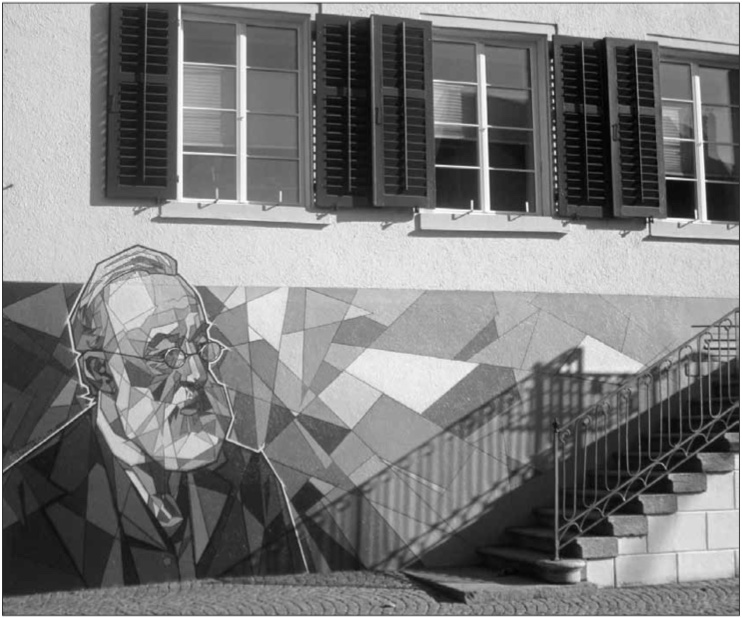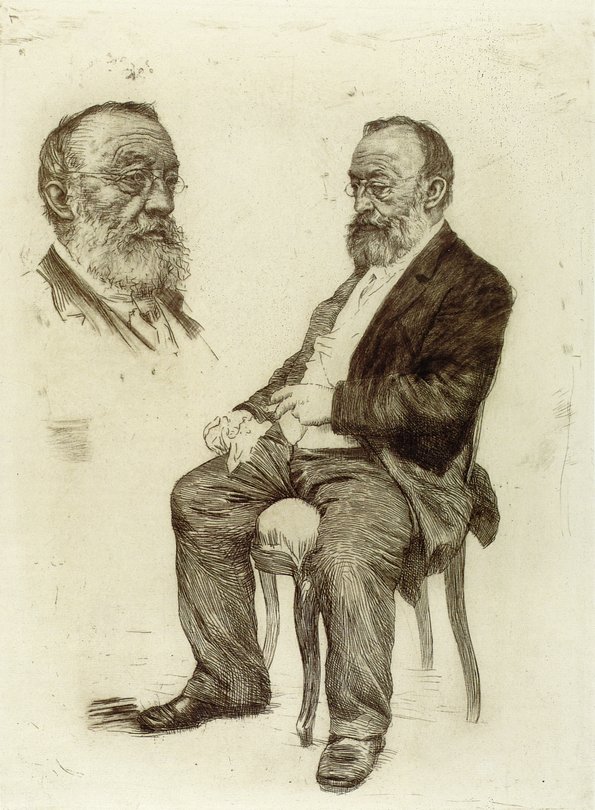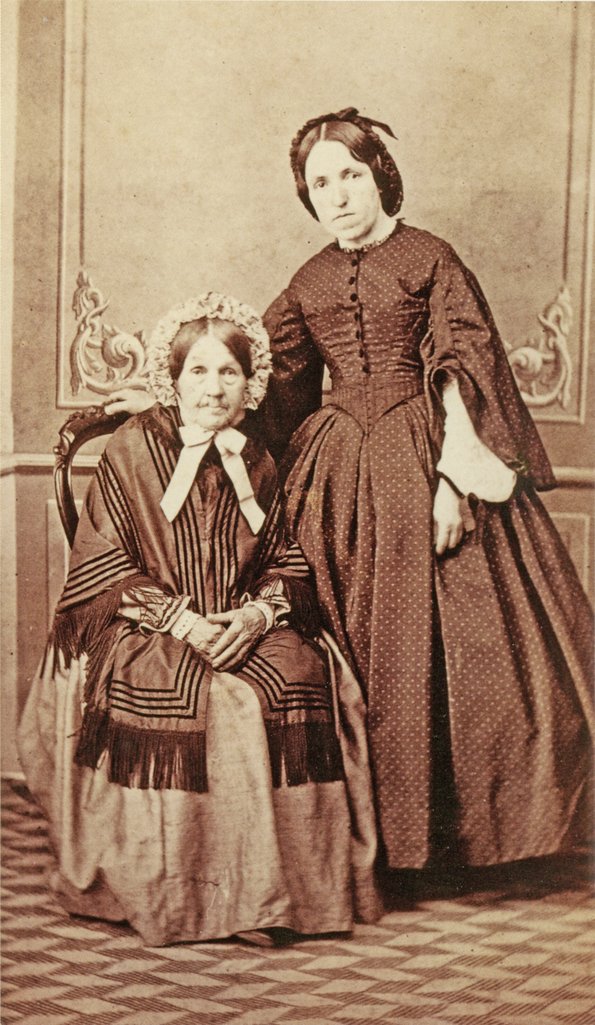Glattfelden highly influenced Gottfried Keller
A rural village has inspired a great writer
by Heini Hofmann
The city of Zürich immediately comes to thought at the mention of Gottfried Keller, as it is Zürich where the great poet and thinker worked and lived. However, the village of Glattfelden is a second hotspot that must be noted in connection with Gottfried Keller. It is here, the pretty rural village “in the remotest nook of the country … in a green valley of meadows” not far from the Rhine, where “Green Henry” has his roots.

Glattfelden was therefore also in a celebratory mood in honor of Gottfried Keller’s 200th birthday. The Gottfried Keller Centre founded in 1985, is housed in an exemplary restored building dating from 1526 and is situated in the centre of the village, amongst old timber framed buildings. A Gottfried-Keller Street, a Grünheinrich (Green Henry) path, a Grünheinrich village fountain and a statue of Judith keep the memory of Gottfried Keller alive in Glattfelden.
The poet’s path
The quaint city centre provides an intimate backdrop and brings the memory of Gottfried Keller alive. The permanent exhibition, with loans from the Zurich Central Library portrays the importance of Glattfelden for Gottfried Keller. Gottfried Keller’s parents originated in Glattfelden. A special exhibition “From Life to Literature” together with a film pay tribute to his work. All editions of his works, including research literature, are available in the central library which also has a reading room. The venerable Grünheinrich Hall is used for events and the harming Café Judith is named after young Gottfried Keller’s platonic love.
On the scenic poet’s trail from Glatt-felden via Paradiesgärtli, the forays of Green Henry can be retraced and reveal many interesting facts. The highlight of the anniversary activities was a four-day tribute consisting of a village festival and an open-air premier performance of “Kleider machen Leute” (clothes make people) by the Theatre Canton Zurich. A tour of the performance followed the premier in Glattfelden.
Born in the same year as Alfred Escher
Gottfried Keller (19 July 1819 – 15 July 1890) is one of the most important writers and poets of the 19th century. He grew up as a citizen of Glattfelden at the Rindermarkt in Zürich’s old town, where just a stone’s throw away, in the Neuberg at Hirschengraben, Alfred Escher spent his youth. Both men were born in the same year.
Keller’s maternal ancestors include mercenary leaders, heroes of the Burgundian Wars, Bernese patricians as well as families from the Vaud and Neuchâtel. Keller’s ancestors in Glattfelden also belonged to the influential families of the village whose ancestral gallery includes dynasties of knights. One ancestress was the niece of Rudolf Brun, the first mayor of Zurich. The earliest genealogical evidence even points to Emperor Charlemagne.
His father Hans Rudolf Keller, master turner and a man of high humanitarian ideals, died when Klein-Gottfried was only five years old. His mother Elisabeth’s maiden name was Scheuchzer. She was a doctor’s daughter, granddaughter of a tailor and great-granddaughter of a goldsmith. She had a strong character and bore six children, buried four of them and raised two alone. Gottfried’s sister Regula, three years younger than him, was a deft seamstress. She selflessly sacrificed herself for the fatherless family. That is how they got by.
The calming influence of Glattfelden
Many exhibits at the Glattfelden memorial site, such as writings, pictures and everyday objects, are reminiscent of these times, such as the christening bonnet and baby bottle of the Keller children, father’s inherited Viennese clock, the chess pieces made by him there as a turner’s examination work in ivory, silver spoons from mother’s bridal outfit or sister Regula’s cashmere scarf. The focus is of course Gottfried Keller’s reference to Glattfelden. Here, in his home village, he found strength and peace in the turmoil of his youth and the dark years of inner maturation through the “refuge with Mother Nature”.
He lived with the family of his mother’s only brother in the Scheuchzerhaus, a former silk twisting mill below the church at the Mühlbach, which no longer exists today. His paternal uncle and guardian, Johann Heinrich Scheuchzer, was a country doctor and also a farmer and a passionate hunter. He also supported his protégé’s urge to become an artist. Several times, young Gottfried made his way from Zurich to Glattfelden on foot. Here he spent many happy weeks and months which left a lasting impression on him.
This was later reflected in Keller’s greatest achievement, the autobiographical novel “Green Henry”, in which he masterfully described his own youth and relieved his soul from searching and madness. The happy moments in his home village in these difficult phases of life form the most charming chapters in “Green Henry”, and they also appear in the cycle of novelettes “Die Leute von Seldwyla” (Citizens of Seldwyla).
Stations of his life
Fifteen-year-old Gottfried Keller was expelled from secondary school for a minor offence. He turned to landscape painting and travelled to the artist metropolis of Munich in 1840. But after two years he gave up and returned to his mother. From the age of twenty-four he felt called to become a poet. This was followed by years of study in Heidelberg and Berlin on a scholarship from the Zurich government, thanks in part to his friend Konrad Escher. Here he made his breakthrough with the work of the century, the four-volume novel “Der grüne Heinrich” (The Green Henry) and the first novellas to “Die Leute von Seldwyla” (Citizens of Seldwyla).
In 1855 he returned to Zurich. He worked as a critical publicist, cultivated an exchange with artists and intellectuals and made his political mark. His unexpected election as state clerk of the canton of Zurich in 1861 put an end to his material worries. In 1876, at the age of fifty-seven, he resigned from office to return to work again full-time as a writer.
Keller remained unmarried, but was cared for by his mother and sister as long as they were alive.
He admired various remarkable women, including the self-confident Rhinelander Betty Tendering, the Bernese Louise Scheidegger (his fiancée, who tragically took her own life in 1866) and the spirited Viennese Marie Frisch-Exner.
The Gottfried Keller Centre in Glattfelden provides information about all this, as well as about his numerous honours (Dr h. c. Uni Zurich, citizenship of the city of Zurich, Federal Council charter, Gottfried Keller streets in umpteen cities) and the many portraits and monuments of famous artists. In 1890 Gottfried Keller died at the height of his fame in Zurich at the age of seventy-one. The fact that Glattfelden commemorated him would certainly make him happy.
A star in Zurich, a friend in Glattfelden
While urban Zurich is stirring up a celebration for the 200th birthday of its famous figurehead, the farming village of Glattfelden is celebrating modestly but warmly. In Zurich he is celebrated as a star, in Glattfelden as a friend, as “one of us”. For if young Gottfried, in his youthful disruption, had not been able to repeatedly escape the city to the Glattfelden countryside and refuel with his understanding uncle and surrogate father, with his relatives and villagers who took him as he was, and thus find his way and his destiny, Zurich might not have had a reason for a VIP celebration today ...
Glattfelden had a magical attraction for the young Gottfried: it lies in the lowest part of the Glatttal before the Glatt flows into the Rhine and at that time was dominated by agriculture and the textile industry. Situated in a valley basin, shielded by mountain flanks and away from major military roads, the tranquil farming village remained a place of tranquillity giving him strengths – the right environment for a young person in search. It is here where he probably developed his believe system i.e. “Respect every man’s fatherland, but love thine! (“Flag of the seven upright ones”).
A poet with painter’s eyes
This natural idyll, enjoyed to the fullest by “Green Henry”, runs through Keller’s poetic works, even though he never mentions Glattfelden by name. Gottfried Keller interweaved reality and fantasy when describing landscape details or village characters. And nota bene: The detour via landscape painting to poetry was not lost time, as he himself believed, on the contrary: Keller thus became a very special poet, formulating with painter’s eyes.
It is certain that Glattfelden highly influenced Gottfried Keller’s life. However, the small downer in this “geographical love affair”: while Keller was an honorary citizen of Zurich since 1878, he renounced – shortly before his death – the citizenship of Glattfelden. Why, nobody knows. It is only a supposition that this could have happened because the electoral district of Bülach did not appoint him to the Cantonal Council in 1866 after a period of office. Glattfelden is not influenced by this and commemorate its “fellow” with pride and joy. •
(Translation Current Concerns)
Why “green” Henry?
hh. Why did Keller actually call his young hero the “green” Henry? Because he was still immature, wet behind the ears? Or because he loved nature? The poet gives the – banal – answer himself, and it is connected with the family, which was plunged into poverty by the early death of his father: “The clothes I received at that time were green, because my mother had a costume made for me from my father’s uniform pieces.”
Glattfelden and Gottfried Keller Gottfried Keller Centre:
Gottfried-Keller-Str. 8, 8192 Glatt-felden, phone +41 44 867 22 32, www.gkz.ch;
Guided tours on request at any time. – Gottfried-Keller-Dichterweg: all year round; guided tours on request.

